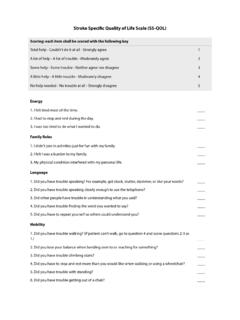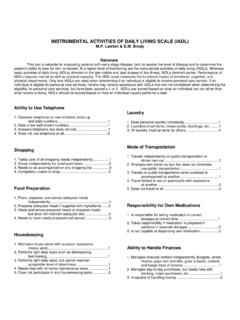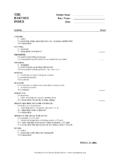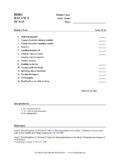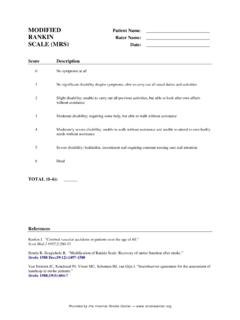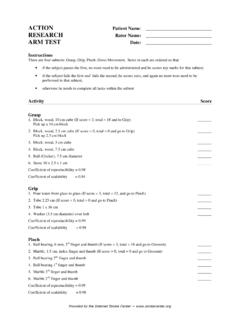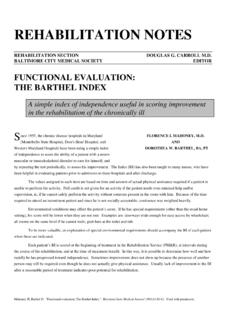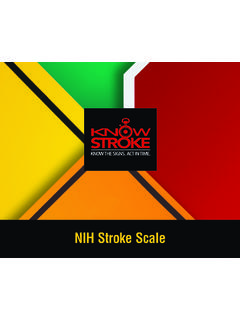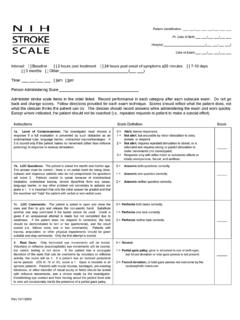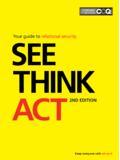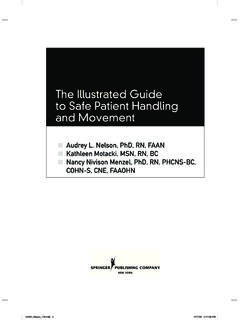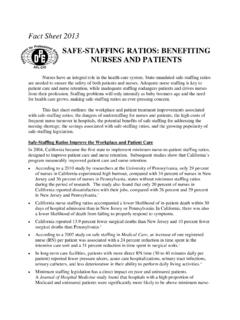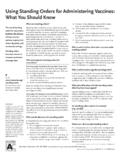Transcription of Recovering After a Stroke: A Patient and Family Guide
1 Recovering After a stroke : A Patient and Family Guide 1 Recovering After a stroke : A Patient and Family Guide Consumer Guide Number 16 AHCPR Publication No. 95-0664: May 1995 US Agency for HealthCare Research and Quality Purpose of This Booklet This booklet is about stroke rehabilitation. Its goal is to help the person who has had a stroke achieve the best possible recovery. Its purpose is to help people who have had strokes and their families get the most out of rehabilitation. Note that this booklet sometimes uses the terms " stroke survivor" and "person" instead of " Patient " to refer to someone who has had a stroke .
2 This is because people who have had a stroke are patients for only a short time, first in the acute care hospital and then perhaps in a rehabilitation program. For the rest of their lives, they are people who happen to have had a stroke . The booklet also uses the word " Family " to include those people who are closest to the stroke survivor, whether or not they are relatives. Rehabilitation works best when stroke survivors and their families work together as a team. For this reason, both stroke survivors and Family members are encouraged to read all parts of the booklet. What is a stroke ? A stroke is a type of brain injury.
3 Symptoms depend on the part of the brain that is affected. People who survive a stroke often have weakness on one side of the body or trouble with moving, talking, or thinking. Most strokes are ischemic (is-KEE-mic) strokes. These are caused by reduced blood flow to the brain when blood vessels are blocked by a clot or become too narrow for blood to get through. Brain cells in the area die from lack of oxygen. In another type of stroke , called hemorrhagic (hem-or-AJ-ic) stroke , the blood vessel isn't blocked; it bursts, and blood leaks into the brain, causing damage. Strokes are more common in older people.
4 Almost three-fourths of all strokes occur in people 65 years of age or over. However, a person of any age can have a stroke . A person may also have a transient ischemic attack (TIA). This has the same symptoms as a stroke , but only lasts for a few hours or a day and does not cause permanent brain damage. A TIA is not a stroke but it is an important warning signal. The person needs treatment to help prevent an actual stroke in the future. A stroke may be frightening to both the Patient and Family . It helps to remember that stroke survivors usually have at least some spontaneous recovery or natural healing and often recover further with rehabilitation.
5 Recovering After a stroke : A Patient and Family Guide 2 Recovering From stroke The process of Recovering from a stroke usually includes treatment, spontaneous recovery, rehabilitation, and the return to community living. Because stroke survivors often have complex rehabilitation needs, progress and recovery are different for each person. Treatment for stroke begins in a hospital with "acute care." This first step includes helping the Patient survive, preventing another stroke , and taking care of any other medical problems. Spontaneous recovery happens naturally to most people. Soon After the stroke , some abilities that have been lost usually start to come back.
6 This process is quickest during the first few weeks, but it sometimes continues for a long time. Rehabilitation is another part of treatment. It helps the person keep abilities and gain back lost abilities to become more independent. It usually begins while the Patient is still in acute care. For many patients, it continues afterward, either as a formal rehabilitation program or as individual rehabilitation services. Many decisions about rehabilitation are made by the Patient , Family , and hospital staff before discharge from acute care. The last stage in stroke recovery begins with the person's return to community living After acute care or rehabilitation.
7 This stage can last for a lifetime as the stroke survivor and Family learn to live with the effects of the stroke . This may include doing common tasks in new ways or making up for damage to or limits of one part of the body by greater activity of another. For example, a stroke survivor can wear shoes with velcro closures instead of laces or may learn to write with the opposite hand. What Happens During Acute Care The main purposes of acute care are to: Make sure the Patient 's condition is caused by a stroke and not by some other medical problem. Determine the type and location of the stroke and how serious it is.
8 Prevent or treat complications such as bowel or bladder problems or pressure ulcers (bed sores). Prevent another stroke . Encourage the Patient to move and perform self-care tasks, such as eating and getting out of bed, as early as medically possible. This is the first step in rehabilitation. stroke survivors and Family members may find the hospital experience confusing. Hospital staff are there to help, and it is important to ask questions and talk about concerns. Before acute care ends, the Patient and Family with the hospital staff decide what the next step will be. For many patients, the next step will be to continue rehabilitation.
9 Recovering After a stroke : A Patient and Family Guide 3 Preventing Another stroke People who have had a stroke have an increased risk of another stroke , especially during the first year After the original stroke . The risk of another stroke goes up with older age, high blood pressure (hypertension), high cholesterol, diabetes, obesity, having had a transient ischemic attack (TIA), heart disease, cigarette smoking, heavy alcohol use, and drug abuse. While some risk factors for stroke (such as age) cannot be changed, the risk factors for the others can be reduced through use of medicines or changes in lifestyle.
10 Patients and families should ask for guidance from their doctor or nurse about preventing another stroke . They need to work together to make healthy changes in the Patient 's lifestyle. Patients and families should also learn the warning signs of a TIA (such as weakness on one side of the body and slurred speech) and see a doctor immediately if these happen. How stroke Affects People Effects on the Body, Mind, and Feelings Each stroke is different depending on the part of the brain injured, how bad the injury is, and the person's general health. Some of the effects of stroke are: Weakness (hemiparesis--hem-ee-par-EE-sis) or paralysis (hemiplegia--hem-ee-PLEE-ja) on one side of the body.
